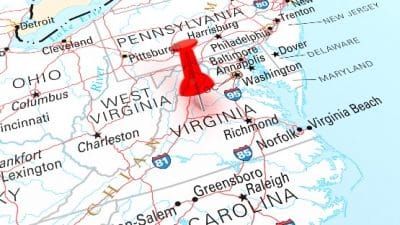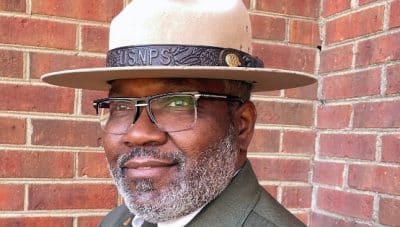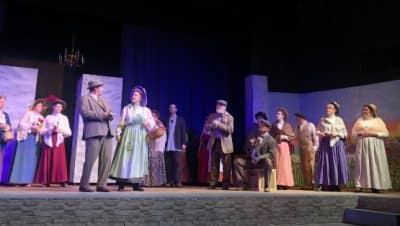Story by Chris Graham
It really is a different world up there on the Appalachian Trail – one that appeals to high-school and college students, people going through various mid-life crises, recent retirees and, more and more these days, in particular, artists and filmmakers.
“You really have a lot of elements with the Appalachian Trail that are great for storytelling. One, it’s a unique world that I think people are really fascinated by because it’s so unusual. But two, I think the majority of the people there is at a crossroads in their lives,” said Ben Wagner, who made a feature film set on the Trail, “Southbounders,” that opened at the 2005 Los Angeles Film Festival and is now making its way up the East Coast with screenings in communities situated along the 2,000-plus-mile AT.
“All sorts of different things motivate people to do things – and from a storytelling standpoint, if you can take a character that’s grappling with issues in their lives and sort of force them to deal with them, that’s a great source of drama. For me, that’s why it works so well. It’s because you’re taking a character and forcing them to confront things in their life. And I think that’s a great inspiration for a story,” Wagner told The Augusta Free Press.The inspiration for documentary filmmaker Douglas Morse – whose film “2000 Miles to Maine” debuted in 2004 – was similar in nature. Morse set out to chronicle the hundreds of hikers who set out with the idea of covering the entire Georgia-to-Maine AT only to reverse course – sometimes on the first day out.
“I had read Bill Bryson’s book – and I was really struck by the fact that so many people really had no clue what they were getting into,” said Morse, referencing Bryson’s acclaimed A Walk in the Woods, released in 1998, which offered a humorous take on the culture of the Trail.
“That you could have out of 2,000 people who were starting, a good 10 percent drop out in the first 30 miles. That was crazy to me. I’m a long-time hiker, and I didn’t understand how someone could set out on a long-distance hike and then quit after 30 miles when they still had over 2,000 to go,” Morse told the AFP.
The driving force for Mark Flagler in putting together his 2005 film “Appalachian Impressions” was more basic – his goal, he said, was to “highlight the AT as a social trail.”
“The most interesting part of all long-distance trails is that there is a group of people that for some reason decide to hike from Georgia to Maine or Mexico to Canada for three months, four months, six months – and there’s that mystique of, why do people do this? I tried to show that in the program that I did. That’s probably the most intriguing aspect of all long-distance hiking from other people’s perspectives,” Flagler said.
“When the program aired on PBS, people watched the program probably because they’re like, Wow, I can’t believe somebody would want to hike 2,100 miles. What are they – crazy? Why would they want to do this? Are they running away from something – or are they trying to find something?” Flagler said.
Penn State professor Ian Marshall is among those who hiked the Trail in the effort at trying to find something.
“The appeal of the Trail to me, as someone who’s interested in American literature, is that it’s almost a time-travel machine – to walk on a mountain that is not too different today than the way it might have been 200 years ago. And just to read what a writer has written about that piece of terrain, and to try to experience the same thing, that feels magical to me – to feel that, Here I am, in the same place that Henry Thoreau was,” said Marshall, who based his review of AT literature – Story Line: Exploring the Literature of the Appalachian Trail – on his experiences on the Trail.
“When I was hiking, I would bring the literary works that were about that place in my pack – and I would be reading, for instance, if I was up in the White Mountains, I would have a collection of Hawthorne short stories. I’d be reading the stories by Hawthorne while I’m in the place that he’s writing about – and then I’d be writing in my journal thinking about the literature and thinking about the place and trying to find where the two connect,” Marshall said.
“Aside from the physical sensation of hiking the Trail, it became a real intellectual adventure, too – because I was always reading and writing while I was up there. I had lots to think about during the day while I was putting in the miles. I’d be thinking, Oh, Robert Frost was here, and let me think about this Frost poem and this place. It made for some really interesting mind work while I was walking,” Marshall said.
“It was a great way to focus my mind,” Marshall told the AFP.
Marshall, Flagler, Morse and Wagner all started out with the idea of using the Trail as something of an artistic tableau. Each came away with more than what they had set out for in that respect.
Marshall, for one, can tell the tale of the story of a Cherokee myth that inspired his Trail name – Evergreen – that came to life for him on a dreadful day on the AT.
“I was hiking down South and reading the Cherokee myths, and I was having a really bad day. I ended up in a place called Low Gap, which was fitting, because I was really low. I had blisters, I was mildly hypothermic. It was a cold, rainy day – and I ended up at Low Gap just shivering and wet and pretty miserable,” Marshall said.
“I took out my reading for the day – and it was this Cherokee myth, a story about when all the living things were placed on earth, they were told to stay awake and fast for seven days and seven nights,” Marshall said. “Well, one by one, all the animals and plants started to fall asleep. The only ones who made it among the animals were the owl and the panther – so they were given the power to see in the dark so that they could hunt while everyone else was asleep. Among the plants, the only ones that made it were the evergreens – the pines, the spruce, the laurels. And so they were allowed to keep their hair in the winter.
“I thought it was a nice parable and lesson about fortitude – sticking with it even when you had a bad day. If you can make it through the ritual, there’s a reward. And the name stuck,” Marshall said.
The lesson that Flagler took with him from his experience had to do with the kindness of absolute strangers.
“I talked a lot in my film about the compassion, the support from Trail Angels and the support from people in communities along the Trail,” Flagler said. “I focus at the beginning of the film on one town – Hot Springs, N.C. I wanted to show the audience, this is what you get when you come into town – places to stay, food, things like that, so people watching could have an idea.
“I focused a lot on Trail Angels along the Trail and what they do – everything from handing out sodas to beers to pizza to brownies to snacks or even just taking trash. I think the communities are a big part of the Trail experience – and I did show a lot of towns and what hikers do in towns,” Flagler said.
For Morse, the surprise message of his look into why some people abandon ship after a day or two on the Trail was that it wasn’t always because their experience was altogether negative.
“People who do drop out, that doesn’t mean that they’ve had a bad time out there. It might mean, for some, for many, that they probably had a really great time, but at some point they, for various reasons, had to get off the Trail,” Morse said.
“What you learn out there is that no one is forcing you to do this. You can do it any way you want,” Morse said.
Wagner’s words on this subject are reminiscent of a universal theme in the world of arts and letters – you only live once.
“It’s so unique to be able to do something like that, to be able to do something like hike the Appalachian Trail,” Wagner said.
“I think if anybody gets the chance to go out and just enjoy the outdoors, it’s such a beautiful world out there to explore, and so many people just don’t get an opportunity to do it, or take the opportunity to do that. And then when you think about something like through-hiking, which is just an enormous undertaking, very few people get the opportunity to do something like that – or even have the ability to take the time or follow through with it,” Wagner said.
(Published 04-17-06)










